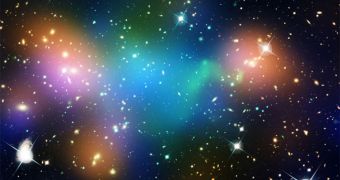A recent image put together from data collected by multiple telescope, reveals a mysterious dark matter core in the galaxy cluster Abell 520. The formation is located about 2.4 billion light-years away.
The photo contains data collected with the NASA/ESA Hubble Space Telescope, the Canada-France-Hawaii Telescope, in Hawaii, and the American space agency's Chandra X-ray Observatory (CXO).
It represents a composite of natural- and false-color images collected by the three observatories. The thing that immediately captured astronomers' attention was the weird distribution of dark matter within this massive cosmic collision zone.
According to the research team, the study appears to have revealed a clump of dark matter. This structure is now believed to be a wreck of an older cosmic collision, but the exact reason for which it exists on its own is not fully understood.
If the finding is confirmed, then astrophysicists may need to revisit an older theory, which suggests that dark matter should ensure that galaxies maintain contact with each other even as they collide head-on.
Dark matter is believed to be a form of matter that interacts with normal, baryonic matter exclusively through the force of gravity. Experts think it's made up of so-called Weakly-Interacting Massive Particles (WIMP), which produce antimatter when they interact with each other.
While the stuff cannot be observed directly, its effects on its surroundings are very obvious. Experts used an observations technique called gravitational lensing to analyze the distribution of dark matter within the core of Abell 520, Science Blog reports.
“This result is a puzzle. Dark matter is not behaving as predicted, and it’s not obviously clear what is going on. It is difficult to explain this Hubble observation with the current theories of galaxy formation and dark matter,” says James Jee.
The study team member holds an appointment as an astronomer at the University of California in Davis (UCD). He was also the lead author of a new paper detailing the findings, which is published in the latest online issue of the esteemed Astrophysical Journal.
The main issue here is that this cluster's dark matter core contains far fewer galaxies than what current models suggested. The implication is that dark matter and galaxies are not anchored together as strongly as investigators first calculated.
According to Jee, this study highlights the need for experts to conduct more dark matter mapping studies in clusters. “We know of maybe six examples of high-speed galaxy cluster collisions where the dark matter has been mapped,” the expert explains.
“But the Bullet Cluster and Abell 520 are the two that show the clearest evidence of recent mergers, and they are inconsistent with each other. No single theory explains the different behavior of dark matter in those two collisions. We need more examples,” he concludes.

 14 DAY TRIAL //
14 DAY TRIAL //